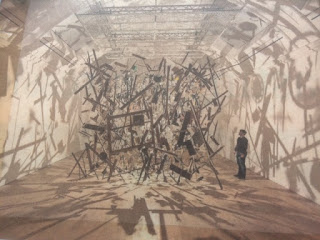My Private Museum Without Walls
Opening the book at random, I find on the left-hand page a single-figure painting by Picasso with a well-known work by Bonnard featuring a woman and a cat at a table. Next to the Picasso at the top is at typical work by Nicholas de Stael, made up of thick slabs of impasto. Below it is a portrait of a man at a table by Bernard Buffet in his characteristic style, with thick black lines round the figure and utensils, and thinner scoring agitating the large areas.
On the opposite page are three works by Dubuffet, two painting and a piece of sculpture.
I find the Picasso of little interest. I have many such works scattered throughout my scrapbook. They are late works that have come up for sale and are featuring in newspapers because of the huge prices they are fetching. I surprise myself by finding the Bernard Buffet, in this instance, slightly more successful than the Picasso. Bonnard, on the other hand, is a remarkably consistent painter, a wonderful colourist whose surface areas are carefully enlivened with subtle variations.
De Stael is typical of a number of artists who came to prominence in France as a second wave after the great modern innovators. Bissiere was another. Each has an instantly recognisable style - so much so that it looks as though they had only one idea apiece on which they made variations. Bernard Buffet might be seen as a realist version in the same mode.
Jean Dubuffet is the real French survivor from this time. He constantly reinvented himself. One of the reproduced paintings on my page devoted to the artist is entitled Cité Fantoche, 1963. The other, of a car with two figures, is obviously from the same period. They are are oil paintings with deliberately childish figures isolated with thick lines. Unlike Picasso's often geometric rearrangements of human features, Dubuffet's delineations have something in common with Klee's idea of taking a line for a walk. Like Bonnard, his large areas are varied with touches of superimposed brushstrokes but with much more impasto. Elsewhere in my collection, I have another Dubuffet painting, Paris Polka. The technique is very similar but it is a completely abstract work.
The reproduction of Dubuffet sculpture belongs to one of his less successful stylistic incarnations: cutting from blocks of polystyrene with a hot wire, he produced pieces consisting of multiple figures which he then painted in bright colours. The example I have is of a single figure and all the better for it.



Comments
Post a Comment